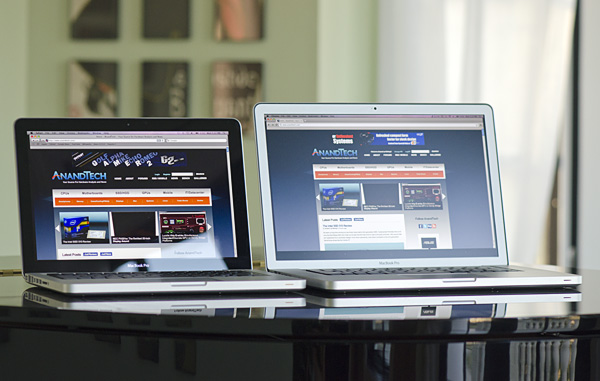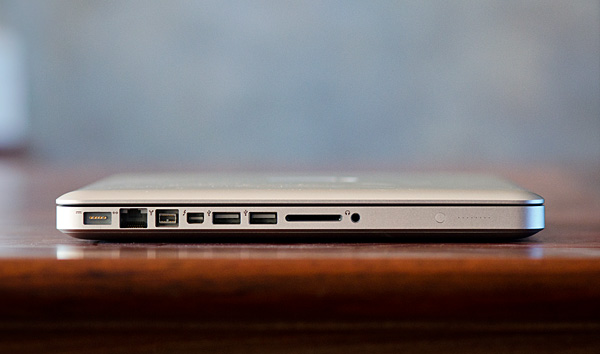The MacBook Pro Review (13 & 15-inch): 2011 Brings Sandy Bridge
by Anand Lal Shimpi, Brian Klug & Vivek Gowri on March 10, 2011 4:17 PM EST- Posted in
- Laptops
- Mac
- Apple
- Intel
- MacBook Pro
- Sandy Bridge
Final Words
For as little attention as the 2011 MacBook Pro launch was given by Apple, there sure is a lot to talk about.
The advantages are numerous. With the 13-inch MacBook Pro, under OS X at least, there simply aren't any downsides. You get much better CPU performance over the previous generation. In fact, the new 13 can outperform last year's 15 thanks to Sandy Bridge. The new 13 is quite possibly the best balance of portability and performance. It's the single largest upgrade you'll find in the lineup. If you own a previous generation 13-inch MBP, the upgrade is 100% worth it. Graphics performance is solid under OS X however questionable under Windows. For some reason we actually saw a step back in GPU performance vs. last year's 13-inch MBP when running games in Windows 7.
The 15-inch MacBook Pro is a beast. Although it comes in the same chassis as last year's model, it delivers much more performance. The move to quad-core Sandy Bridge makes the 15-inch MacBook Pro's performance formidable. Whereas I couldn't use the 2010 15 as my primary work machine, with an SSD the 2011 15-inch MBP does just fine.
Displays haven't really changed, which is both good and bad. On the one hand, Apple's MacBook Pros have always used good quality panels. On the other hand I'd like to see a higher res option for the 13-inch display—1280 x 800 is a big turnoff for me with the 13-inch model.
Thunderbolt is a nice addition however I expect that it'll be grossly underused for a while. We'll see some nice Thunderbolt enabled external storage solutions this Spring (helping perpetuate the mobile desktop usage model), but it'll be a while before we get the single-cable carrying USB, Ethernet, FireWire and DisplayPort to a display.
The WiFi improvements are welcome, although surprisingly absent from Apple's marketing collateral. The front facing 720p camera is also a nice touch.
It's not all rosy however. Apple fails to really take advantage of one of Sandy Bridge's biggest features: Quick Sync. The hardware encoder is used in FaceTime HD but you still get some very high CPU usage (at least of a single core). There's no support in QuickTime or iMovie 2011 for Quick Sync as of now, which is a major disappointment.
I mentioned that the 15-inch MacBook Pro is easily a desktop replacement, however you do have to deal with a loud fan under heavier CPU loads. Something a well designed desktop won't bother you with.
SSD support is still problematic. There are far too many reports of drives that don't work properly in the 2011 MacBook Pro, and Apple refuses to validate/ship anything but fairly mainstream SSD solutions. To make matters worse, although TRIM is finally enabled under OS X—it only works on Apple branded SSDs. I can understand Apple's desire to want to avoid dealing with the pitfalls of early SSDs with questionable firmware maturity, but I also believe it's Apple's duty to support as much hardware that's out there in the market today. If Apple offered something with SandForce SF-2200 class performance I'd have less of a bone to pick, but presently it doesn't.
Then there are the concerns about battery life. Under light usage there's a clear improvement over last year's models. The new 15-inch MacBook Pro is good for anywhere between 7—9 hours of light usage. That is assuming you don't have the dGPU running of course, at which point you should start talking about numbers below 5 hours. Even without the discrete GPU enabled, in the hands of a multitasker the new 15-inch MacBook Pro can easily burn through its 77Whr battery quicker than last year's model. While our worst case numbers don't look much lower than the 2010 model, the chances of you getting less than 2.5 hours out of the new 15 are much higher than they were last year.
The new 13-inch model is less of a concern when it comes to battery life. It's still got a 35W TDP dual-core CPU and no discrete GPU to sap power. It's the move to four cores and the additional GPU that really hurt the 15-inch MacBook Pro under heavy usage.
Overall the new lineup is a significant step forward. As I mentioned earlier, if you're in the market for a 13-inch system the 2011 Sandy Bridge MacBook Pro is likely the one to get. The 15 is just as easy to recommend, provided you're ok with the downsides (higher temperatures, louder fans, shorter battery life under load). If you aren't ok with the downsides, just wait another year and get the Ivy Bridge based successor.












198 Comments
View All Comments
zhill - Friday, March 11, 2011 - link
Hmm... so I mostly disagree, but the fact that there is some confusion is problematic as well.I assumed (the need to assume is the problematic part) that the main battery life tests (Web loads, etc) were run with OSX doing whatever it wants. The point of the gfxCardStatus tests was to specifically point out the difference in power consumption with each card being used. The only way to expose that behavior explicitly is to manually enable/disable the dGPU.
So, I think the methodology makes sense, but I agree that Anand should make it clear in the general battery-life section that OSX is managing the GPU in stock form with no gfxCardStatus inferference.
7Enigma - Friday, March 11, 2011 - link
I ran the numbers. The values (in minutes) that were reported in the 1st and 3rd charts of page 15 which correspond to the light and Flash-based web surfing are dead on the bottom of page 9 numbers where the discrete GPU has been TURNED OFF.It is so bad that after running the numbers if you were to use the data from page 9 the 15" MacBook Pro would be so far in last place on the Flash-based chart (at 177minutes) that the next highest is over an hour and a half LONGER.
zhill - Friday, March 11, 2011 - link
I believe he's using Safari in the web and flash web tests, and mentions:"Another contributing factor is the new 32nm iGPU which is active full-time under Safari. " When discussing the Flash problem (on pg 9) he specifically mentions Chrome + Flash activating the dGPU.
So, the question is: what is the dGPU behavior for other browsers? Do Firefox and Safari only use the iGPU or is the dGPU activation only in Chrome? It needs to be addressed in the article more fully for no other reason than clarity and so users will know that choice of browser may impact battery life very significantly.
7Enigma - Friday, March 11, 2011 - link
That is a good point (missed the Chrome/Safari switch), but it is also puzzling that the numbers from both charts match up perfectly. I would have expected a bit of difference between Chrome and Safari even if the dGPU issue is taken away just due to coding differences, but if you divide the minutes by 60 from the earlier page you'll get the EXACT same number of hours posted in the later battery numbers. The only way to describe this without it being the same number would be if they are comparing numbers from 2 different browsers in the same chart without labeling as such which I find very hard to believe.7Enigma - Saturday, March 12, 2011 - link
Seriously not a single reply from one of the authors?IlllI - Friday, March 11, 2011 - link
theres hardly much difference between the 13in model and the 17in. so basically you are paying $1000 more for 4 inches.alent1234 - Friday, March 11, 2011 - link
i5 to i7, discrete GPU, more hard drive spacealmost same price difference if you went with dell/hp
khimera2000 - Friday, March 11, 2011 - link
Just so you know looking at the recommended configuration of hp envy cost 1932, a maxed out 3D vision dell xps 17 cost about 2480 but has a sell that brings it down to 2244 (dual HDD no SDD) where as the base configuration of the mac cost 2500. so..,. no even if you throw in the discreet, I7 increased harddrive space your still over the mark when you compare to windows notebooks.How did i find these numbers? opened up the web sight for each respective company and looked at what they had as of 5:00 PM 3/11/2011 applicable to US customers (after all they where the US versions of the sight) except for dell no others where offering an automatic discounts.
jed22281 - Friday, March 11, 2011 - link
Should've done the 13" and then jumped up to the 17".Is there some reason you're not interested in the 17" versus the 15"?
Thanks!
jed22281 - Saturday, March 12, 2011 - link
Anand, Brian, or Vivek?Thanks!